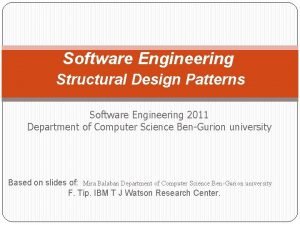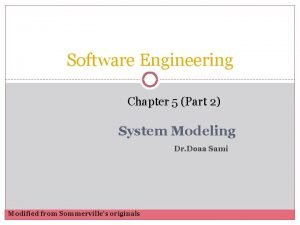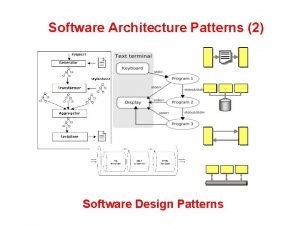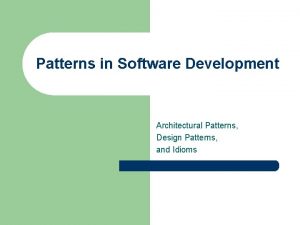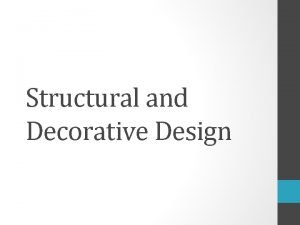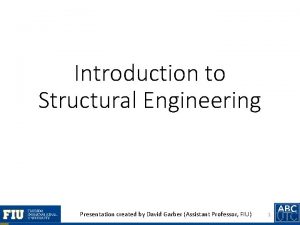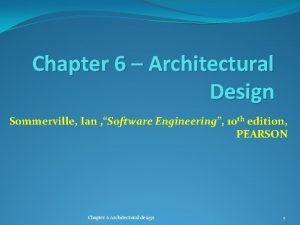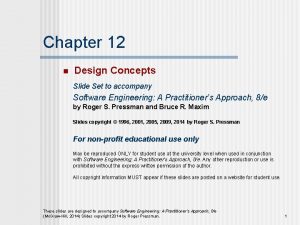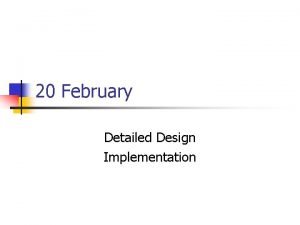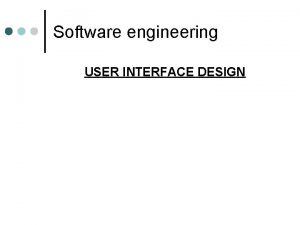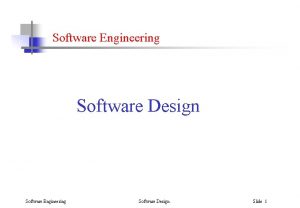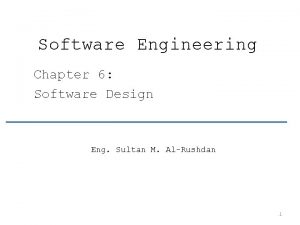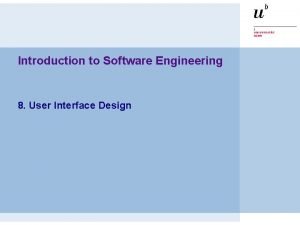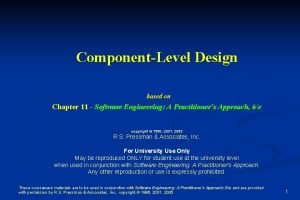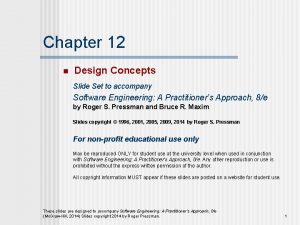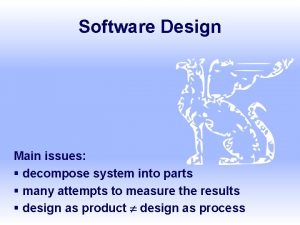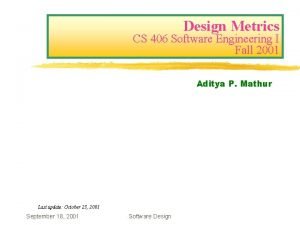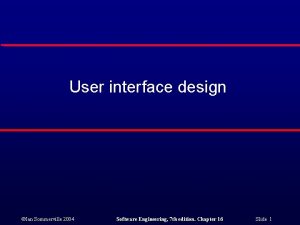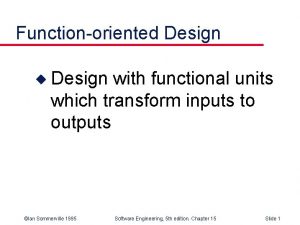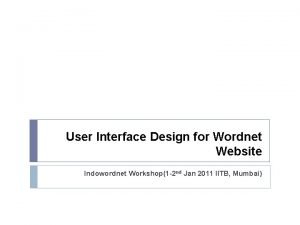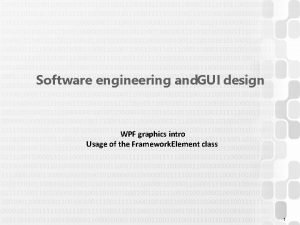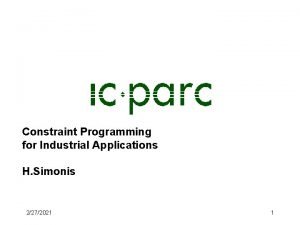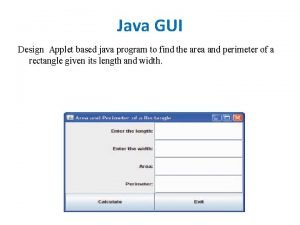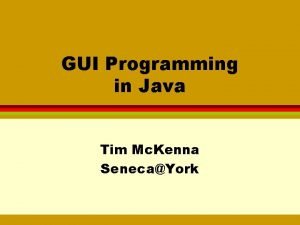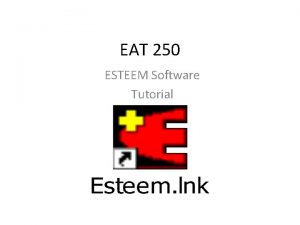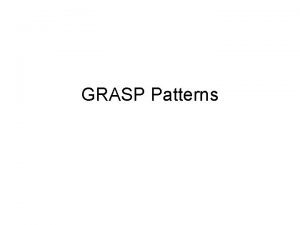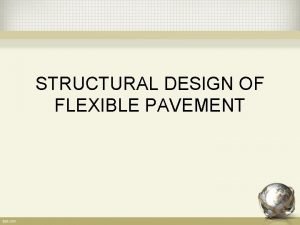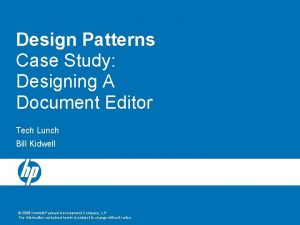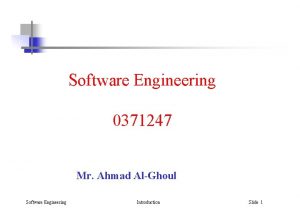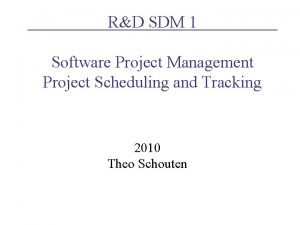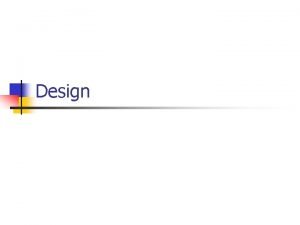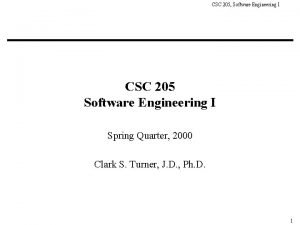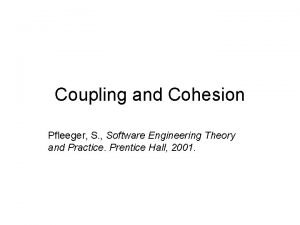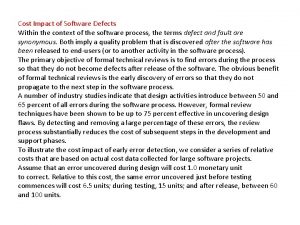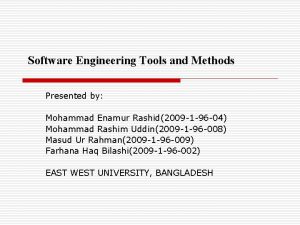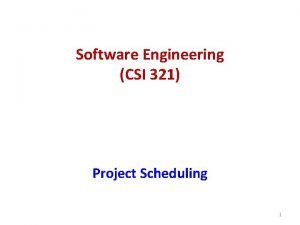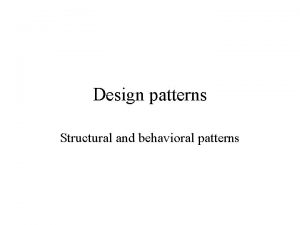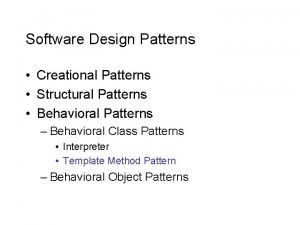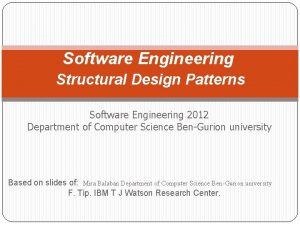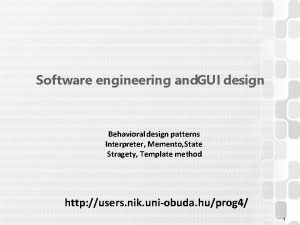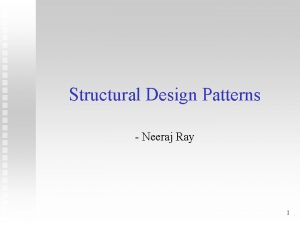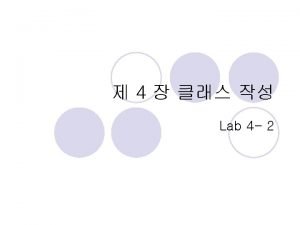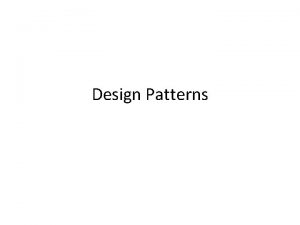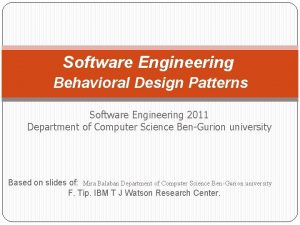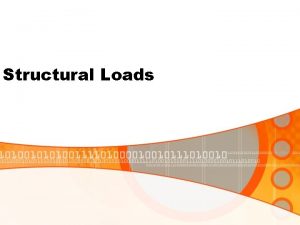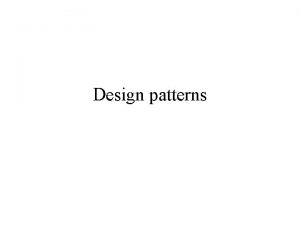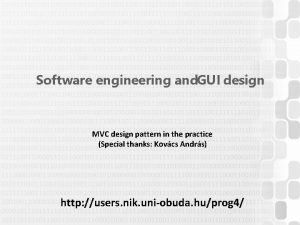Software engineering and GUI design Structural design patterns














































































- Slides: 78

Software engineering and. GUI design Structural design patterns Adapter, Bridge Composite, Flyweight Facade, Proxy, Decorator http: //users. nik. uni-obuda. hu/prog 4/ 1

Purpose Design pattern Short description Structural Adapter Use an existing class/interface in place of a different class/interface Wrapper class Bridge Split up a big hierarchy into two hierarchies and connect them using composition Dependency injection Composite A tree data structure where the same operations are possible with the leaves, the subtrees and the whole tree Flyweight Reduce memory usage with shared internal parameters, singleton references, on-the-fly property calculation and instance pooling Façade Front controller, hide internal classes, simplify calls Proxy Transparent Façade AND extra functions/checks before/after the existing ones Decorator Assemble arbitrary functions via composition (dynamic inheritance) 2

Structural Design Patterns Purpose Scope Creational Structural Behavioral Class Factory method Adapter Interpreter Template method Object Abstract factory Builder Prototype Singleton Adapter Bridge Composite Decorator Facade Flyweight Proxy Chain of responsibility Command Iterator Mediator Memento Observer State Strategy Visitor 3

Adapter Object adapter Class adapter 4

Adapter – C# 5

Adapter – C# 6

Adapter – C# 7

Adapter – C# 8

Adapter – C# 9

Adapter –. NET • Not only functionality/method signature-adapters exist • The Data Adapter accepts data from different data sources (SQL Server, Oracle, ODBC, OLE DB) and transforms it into the sourceindependent Dataset/Data. Table types – Sql. Data. Adapter – Odbc. Data. Adapter – Ole. Db. Data. Adapter 10

Adapter –. NET • Not only functionality/method signature-adapters exist • LINQ – Linq provider: IQueryable + IQuery. Provider – Executing the same LINQ expression tree on a different data structure • Entity Framework – Model Adapter: create Db. Context code from an arbitrary database (T 4 code generation , SQL-first method) – Entity LINQ Adapter: From a LINQ query tree, create an SQL query with the dialect of the current connection 11

Bridge • Generally speaking: a hierarchy that depends on two factors • The two factors are usually not identified at the beginning, so we organize the classes into one hierarchy • Typically we only realize later in time, that we have a problem: when we have to insert two-three descendant classes for one modification this is a typical refactoring pattern! • Solution: identify independent factors, cut the hierarchy into two, then connect them using Dependency Injection 12

Bridge 13

Bridge – Before 14

Bridge – Before 15

Bridge – After 16

Bridge 17

Bridge – C# 18

Bridge – C# 19

Bridge – C# • The call itself is the same as with the Strategy pattern • Email. Sender + Encryption. Algorithm = one-sided bridge • Bridge = Dependency Injection (with base class) Bridge = Go. F = 1994 Dependency Injection = Martin Fowler = 2004 https: //martinfowler. com/articles/injection. html 20

Structural Design Patterns Purpose Scope Creational Structural Behavioral Class Factory method Adapter Interpreter Template method Object Abstract factory Builder Prototype Singleton Adapter Bridge Composite Decorator Facade Flyweight Proxy Chain of responsibility Command Iterator Mediator Memento Observer State Strategy Visitor 21

Composite 22

Composite – C# 23

Composite – C# 24

Composite – C# 25

Composite – C# 26

Flyweight – motivation 27

Flyweight 28

Flyweight – C# • Perception: all characters are treatable… Actually, only created/calculated when needed • Optimization FOR MEMORY, don’t care about cpu… • You might not use the pattern as a whole, but the tricks are usable as individual tricks • Used a lot in low-memory / resource-intensive operations: Thread. Pool, Connection Pool, WPF Recycled+Virtualized Listbox, Scrolling UI controls (Android: Recycler. View) 29

Flyweight – C# – Trick#1: Singleton 30

Flyweight – C# – Trick#2 + Trick#3 31

Flyweight – C# – Trick#4: „Local” properties 32

Flyweight – C# – Trick#5: On-the-fly property 33

Flyweight – C# – Trick#6: Object pooling • Object pooling/smart factories – limit=1: Get. Instance() / Create. Instance() [Hidden Singleton Factory] – Without limit or limit>1: Get. Instance() + Release. Instance() [Object Pool Pattern] • . NET: Threadpool, EF Connection. Pool, Virtualized Listbox • Android: scrolling control/Recycler. View • . NET core: System. Buffers. Memory. Pool, System. Buffers. Array. Pool, Microsoft. Extensions. Object. Pool – var rented. Array = System. Buffers. Array. Pool<int>. Shared. Rent(10); – System. Buffers. Array. Pool<int>. Shared. Return(rented. Array); • Very common in resource-scarce scenarios 34

Flyweight – C# – Trick#6: Object pooling 35

Flyweight – C# – Trick#6: Object pooling 36

Flyweight – C# – All Tricks Used Together 37

Flyweight –. NET/JAVA: String (. NET: Type) 38

Structural Design Patterns Purpose Scope Creational Structural Behavioral Class Factory method Adapter Interpreter Template method Object Abstract factory Builder Prototype Singleton Adapter Bridge Composite Decorator Facade Flyweight Proxy Chain of responsibility Command Iterator Mediator Memento Observer State Strategy Visitor 39

Facade 40

Facade 41

Facade • We want to simplify the many internal dependencies, we want a single point of access from the outside • Con: easy to fall into extremes (God Object – Too Many Responsibilities) – Must find the middle ground – This is required in the inter-layer communications in the prog 3/prog 4 projects: ILogic, ICar. Logic, IMonster. Logic? • Composition technique – Proxy/Decorator as well same look, different logical meaning – The Facade class typically adds no extra operations/checks to the method calls – Might define calling order, but its main task is to simplify the method calls and the dependency network – The structure of the Facade class and its existence is KNOWN 42

Facade – C# 43

Facade – VB. NET 44

Facade – Architectural pattern 45

Proxy 46

Proxy • Aim: replace an existing instance with a different one, but all this in a way that the existence of the proxy is NOT necessarily known • It is a very common design pattern – EF: Db. Context. Save. Changes() might save proxied entities – Linq: query results are iterator proxies (Move. Next+Current) • Types – Remote proxy : looks like a local reference, but the real instance is really in another location (Class? App? Network? ) – Virtual proxy: all properties seem like they are always set, but the expensive instances are only created when accessed (partial lazy load) – Protection proxy: controls the access to the instance – Smart Reference: an instance that performs extra operations when calling already existing methods (measurement , lazy load, lock, cache) 47

Proxy – EF / Moq 48

Proxy – WCF 49

Proxy – WCF 50

Proxy – g. RPC proto 51

Proxy – g. RPC Server + Client 52

Proxy – C# example 53

Proxy – C# 54

Proxy – C# 55

Proxy – C# 56

Decorator 57

Decorator • Composition (like the facade/proxy), the decorator class has the same base class/implements the same interface as the class hidden with the composition • Very flexible – With some functions, it can behave like a façade (pass-through) – Some functions can be extended, as with a proxy – It can add completely new functionality/methods as well • Consequences – Since same base class/interface, a decorator can be used to decorate an X class, or another decorator of the same type – Same base class/interface, so the class that doesn`t know about the decorator can use the decorated instance without problems – Add/remove responsibilities/functionality dynamically – Dynamic inheritance = huge flexibility 58

Facade vs Proxy vs Decorator Pattern Adds Logic? Can be stacked? NO Facade NO (max. order) Proxy YES RARELY (only pre/post) RARELY Decorator YES (fully new) YES (But can work without) YES!!!! Known? YES 59

Decorator 60

Decorator –. NET 61

Decorator – WPF 62

Decorator – C# 63

Decorator – C# 64

Decorator – C# 65

Decorator – C# 66

Decorator – C# 67

Decorator – C# 68

Decorator – C# 69

Decorator – C# 70

Decorator – C# 71

Decorator – C# 72

Composition with the structural patterns • Cannot be decided that which one is used, just by looking at the code they all use composition, data field of a related class • Adapter convert to different signature/data format/representation • Bridge connect two hierarchies • Façade simplify calls/subsystem access • Proxy add new operations/checks to existing functions • Decorator add completely new functions 73

Go. F Design Patterns Purpose Scope Creational Structural Behavioral Class Factory method Adapter Interpreter Template method Object Abstract factory Builder Prototype Singleton Adapter Bridge Composite Decorator Facade Flyweight Proxy Chain of responsibility Command Iterator Mediator Memento Observer State Strategy Visitor 74

Go. F patterns Purpose Design pattern Short description Creational Factory method Get. Instance(instance. Type) Abstract factory Multiple factories, Get. Instance(factory, instance. Type) or Get. Instance(instance. Type) Singleton Usage of a single instance (. Default /. Current) Prototype Creation of a Deep copy (. Clone()) Builder Creation of an instance using multiple steps/part/processes 75

Purpose Design pattern Short description Behavioral Iterator foreach () { } Chain of resp. Execute a process using multiple process executors Visitor Separate caller and called instance – multiple visitors/visitees: IVisitor. Visit(IVisitor. Acceptor) IVisitor. Accept(IVisitor) Command Encapsulate a request/method call into an instance Observer Separate caller and called instance (using events) Mediator Fully separate caller and called instance (using central hub) State instances that control state transitions Interpreter Convert arbitrary input to arbitrary output Memento Restore previous state Strategy Full implementation/process in the descendants Depend on abstract base class in constructor Dependency injection (via Abstract) Template method Define individual steps in the descendants Usage of virtual methods and method polymorphism 76

Purpose Design pattern Short description Structural Adapter Use an existing class/interface in place of a different class/interface Wrapper class Bridge Split up a big hierarchy into two hierarchies and connect them using composition Dependency injection Composite A tree data structure where the same operations are possible with the leaves, the subtrees and the whole tree Flyweight Reduce memory usage with shared internal parameters, singleton references, on-the-fly property calculation and instance pooling Façade Front controller, hide internal classes, simplify calls Proxy Transparent Façade AND extra functions/checks before/after the existing ones Decorator Assemble arbitrary functions via composition (dynamic inheritance) 77

Thank you for your attention Structural design patterns Adapter, Bridge Composite, Flyweight Facade, Proxy, Decorator http: //users. nik. uni-obuda. hu/prog 4/ 78
 Gui design in software engineering
Gui design in software engineering Design patterns software engineering
Design patterns software engineering Ge gi gue gui güe güi
Ge gi gue gui güe güi Structural design patterns in java
Structural design patterns in java Structural design patterns
Structural design patterns Generalization in software engineering
Generalization in software engineering Real time software design in software engineering
Real time software design in software engineering Software design fundamentals in software engineering
Software design fundamentals in software engineering Blackboard design pattern
Blackboard design pattern Process patterns in software engineering
Process patterns in software engineering Architectural patterns in software engineering
Architectural patterns in software engineering Halstead software metrics example
Halstead software metrics example Structural and decorative design examples
Structural and decorative design examples Stylized decorative design
Stylized decorative design What is system design in software engineering
What is system design in software engineering Forward engineering in software engineering
Forward engineering in software engineering X videos
X videos Software maintenance in software engineering ppt
Software maintenance in software engineering ppt Who invented software engineering
Who invented software engineering What is software metrics in software engineering
What is software metrics in software engineering Example of software crisis
Example of software crisis Dating serves several important functions that include
Dating serves several important functions that include Structural engineering presentation
Structural engineering presentation Sportal iitd
Sportal iitd Functional analysis examples engineering
Functional analysis examples engineering Function black box
Function black box User interface design steps in software engineering
User interface design steps in software engineering Function oriented design in software engineering
Function oriented design in software engineering Design concepts in software engineering
Design concepts in software engineering Architectural design in software engineering
Architectural design in software engineering Design principles in software engineering
Design principles in software engineering Detailed design in software engineering
Detailed design in software engineering Interface design in software engineering
Interface design in software engineering Software engineering slides
Software engineering slides Design structure charts in software engineering
Design structure charts in software engineering User interface design in software engineering
User interface design in software engineering Component-level design in software engineering
Component-level design in software engineering User interface design steps in software engineering
User interface design steps in software engineering Design concepts in software engineering
Design concepts in software engineering Interface design in software engineering
Interface design in software engineering Design issues in software engineering
Design issues in software engineering Webapp design pyramid contains
Webapp design pyramid contains Design for change in software engineering
Design for change in software engineering Design metrics in software engineering
Design metrics in software engineering User interface design process in software engineering
User interface design process in software engineering Function oriented design
Function oriented design Indowordnet
Indowordnet Wpf gui design
Wpf gui design Matlab gui design
Matlab gui design 台大 matlab
台大 matlab Gui design
Gui design Java gui design
Java gui design Python gui design
Python gui design Gui design
Gui design Gui design
Gui design Good interface design
Good interface design Esteem software training
Esteem software training General responsibility assignment software patterns
General responsibility assignment software patterns Structural consultants barking
Structural consultants barking Thumb rule for steel truss design
Thumb rule for steel truss design Structural design methodology
Structural design methodology Pavement structural design
Pavement structural design A case study designing a document editor
A case study designing a document editor Software quality assurance is an umbrella activity
Software quality assurance is an umbrella activity Sink software
Sink software Sebastian coope
Sebastian coope Process and project metrics in software engineering
Process and project metrics in software engineering It and software engineering difference
It and software engineering difference Return architecture
Return architecture Sdm in project management
Sdm in project management Nnn design
Nnn design Transform flow and transaction flow
Transform flow and transaction flow Rigor and formality in software engineering
Rigor and formality in software engineering Procedural cohesion example
Procedural cohesion example Cost of software defects
Cost of software defects Unit-6
Unit-6 Maintenance and reengineering in software engineering
Maintenance and reengineering in software engineering Software engineering tools and methods
Software engineering tools and methods Csi 321
Csi 321




